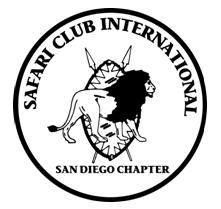San Diego Safari Club International's Southern CA Pronghorn Re-Introduction Project
Often you hear that #HuntingisConservation. We know it's true, but we also love to see it in action. The San Diego SCI Chapter is currently spearheading a Southern CA Pronghorn Re-Introduction Project. The Sonoran and Peninsular sub-species once inhabited South-East California. Read all about the ongoing reintroduction project below: Follow on Twitter: https://twitter.com/SanDiegoSCI
Follow on Instagram: https://www.instagram.com/hunt_omega/
Follow on Facebook: www.facebook.com/sandiegoSCI
Pronghorn Project Update – Part 5
By Bob Smith (Photo by Pete Riger)
These are exciting times for the San Diego Chapter of Safari Club International's Pronghorn Re-Introduction Project! We have made three significant steps since our last update: a) the DNA analysis of animals who were once native to South East California has been completed; b) U. S. Fish and Wildlife Service has taken a strong interest in our project and assigned a biologist to begin preparing documentation for re-introduction of the pronghorn; and c) we now have two sub-species of pronghorn that are viable candidates for re-introduction. Initially, we concentrated on re-introducing the Sonoran sub-species in an area called Chuckwalla Bench, East of the Salton Sea. More recently, we are pursuing the re-introduction of the Peninsular sub-species into the Anza-Borrego Desert State Park. Thus we now have two opportunities to release the first pronghorn into the wild. The Chapter’s goal of initial re-introduction of these animals by mid-2019 is within reach. Below are the details of the activities that got us where we are today.
 Four years ago, the Chapter initiated a project to re-introduce Pronghorn Antelope into Southern California. With the vision for such an ambitious objective proposed by past-President Jim Conrad and the scientific habitat assessments conducted by Kevin Clark of the San Diego Natural History Museum, we quickly had a proposal for where and how to re-introduce these native animals. Chapter member Leif Olsen (currently on assignment by the Navy to Italy) volunteered to be our Project Leader and hit the ground running. One of the first issues was to determine which sub-species of pronghorns once inhabited the areas deemed most suitable in Kevin’s studies. Our chapter began the process of identifying archeological specimens found in South-East California, Northern Baja California, and South West Arizona. We contracted with the University of Arizona to conduct DNA analysis of the specimens and the results show that both the Sonoran and Peninsular sub-species once inhabited South-East California.
Four years ago, the Chapter initiated a project to re-introduce Pronghorn Antelope into Southern California. With the vision for such an ambitious objective proposed by past-President Jim Conrad and the scientific habitat assessments conducted by Kevin Clark of the San Diego Natural History Museum, we quickly had a proposal for where and how to re-introduce these native animals. Chapter member Leif Olsen (currently on assignment by the Navy to Italy) volunteered to be our Project Leader and hit the ground running. One of the first issues was to determine which sub-species of pronghorns once inhabited the areas deemed most suitable in Kevin’s studies. Our chapter began the process of identifying archeological specimens found in South-East California, Northern Baja California, and South West Arizona. We contracted with the University of Arizona to conduct DNA analysis of the specimens and the results show that both the Sonoran and Peninsular sub-species once inhabited South-East California.
Originally, we concentrated on the Sonoran sub-species and established a working group of Pronghorn experts to develop a plan for re-introduction of this sub-species onto the Chuckwalla Bench, East of the Salton Sea. The Chuckwalla Bench was selected because Kevin’s research showed it had the best habitat for pronghorns and the largest area undisturbed by man. Recent DNA results show the Peninsular subspecies also inhabited our study areas. Leif noted that Kevin’s research identified the Anza-Borrego Desert State Park as another suitable habitat that could support a viable population of pronghorns. He then suggested we consider two re-introduction sites, the Chuckwalla Bench for Sonoran Pronghorn and the Anza-Borrego Deseret State Park for the Peninsular Pronghorn. This approach is appealing to all parties because both sub-species are endangered and the organizations supporting the preservation of the sub-species have a goal of establishing sustainable populations in the wild. In addition, having two distinct sites for re-introduction will prevent the sub-species from cross-breeding and corrupting their gene pools.
For the Sonoran re-introduction, we have been working closely with the Sonoran Pronghorn Recovery Team. They have a successful re-introduction program in Southern Arizona. They can provide critical expertise in the capture, re-introduction and nurturing of the Sonoran Pronghorn and would be the source of animals to be re-introduced onto the Chuckwalla Bench. We have also been coordinating with the California Department of Fish and Wildlife, the Arizona Department of Game and Fish, the Bureau of Land Management, the U. S. Fish and Wildlife Service, and the Marine Corps Air Station Yuma.
For the more recent Peninsular re-introduction initiative, we have begun discussions with personnel at the Anza-Borrego Desert State Park, U. S. Fish and Wildlife Service and San Diego Zoo Safari Park. All parties involved have shown enthusiasm for this initiative and volunteered to further explore a plan for the project. The Safari Park is particularly interested because they have a breeding program and a register for the Peninsular Pronghorn and, like us, are anxious to see them re-introduced into the wild. The Safari Park has agreed to host our next planning meeting in November, 2016.
As you can imagine, it is a daunting task to get consensus of so many organizations to pursue such an ambitious project as we have proposed. But due to the efforts of Leif and the continued support of Kevin and our Chapter, we believe consensus has been achieved and we can now proceed with the execution phase of the project. The next year promises to be very exciting as we see the vision for this project come to fruition.


